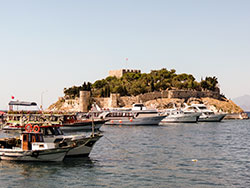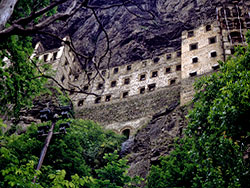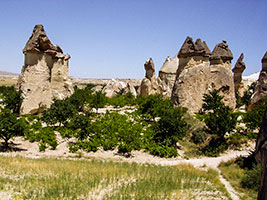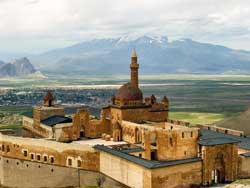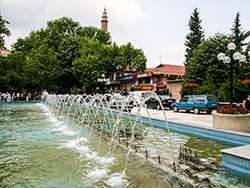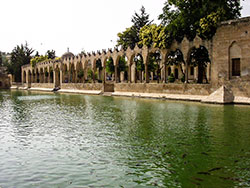Sardis (also Sardes, Sart in Turkish), the city of King Croesus with his legendary wealth, was one of the most important cities of Asia Minor. Today, the remains of the Greco-Roman city with its restored Bath-Gymnasium complex and the great synagogue provide spectacular views.
Historical Background
Sardis has a long history that goes back as far as 1200 BCE, but much older occupation levels have been excavated, going back to the Early Bronze Age and the Neolithic Period in 3rd-7th millennium BCE. Sardis was established near the Pactolus river (present Sart Çayı), which carried specks of gold that washed down from the nearby mountains. The local Lydians draped sheepskins into the river to catch the gold, a technique that was also used in other places such as Colchis and probably gave rise to the legend of the Golden Fleece. This gold-working industry brought enormous wealth to Sardis and its ruling dynasty, and allowed Sardis, as the capital of the kingdom of Lydia, to be the first city to produce coins. Sardis was a major city covering over 115 hectares (290 acres), whose fortified citadel (acropolis) controlled a natural corridor linking the Aegean coast with central Anatolia. This strategic position, the fertile soil and the gold deposits contributed to the remarkable growth and prosperity of the city.
Sardis was the major city and capital of Lydians, an Anatolian people. The kings of Lydia Gyges, Alyattes, and Croesus were fabulously rich and created a powerful empire in the 7th and 6th century BCE. The most famous ruler was King Croesus, who ruled from 560 BCE until his defeat by the Persians in 546 BCE. His father Alyattes created the first coins in history made from electrum, a naturally occurring alloy of gold and silver. However, since the composition of electrum could vary, so did the value of the coin. Under King Croesus, Lydian metallurgists discovered how to extract pure gold from electrum by heating it with salt (sodium chloride), thus creating the opportunity for Croesus to issue reliable gold coins with a stable value. These first gold coins were known throughout the ancient Greek world as Croeseids.
The Lydian kings used their incredible wealth to expand their empire, such that by 550 BCE they controlled most of Anatolia. At the same time, Cyrus the Great had established the Persian Achaemenid Empire and had conquered the Median Empire, that extended to Central Anatolia. Croesus consulted the Delphic oracle whether he should go to war with Cyrus. The oracle returned the ambiguous answer that if Croesus attacked the Persians, he would destroy a great empire. And so it happened, but the great empire that was destroyed was his own, not that of Cyrus.
After the defeat of Croesus, Sardis was incorporated into the Persian Empire as one of its most important cities and the seat of a Persian satrap. It was conquered by Alexander the Great and after his death, it became the seat of a Seleucid satrap. Sardis was incorporated into the Roman Empire in 133 BCE and became the administrative centre of the Roman province of Lydia and the seat of a Roman proconsul. In 17 CE, the region was struck by a massive earthquake that destroyed most of the city, but the help of the emperor Tiberius it was rebuilt and began its final phase as a great city. In Late Roman times (4th-7th century CE) and Byzantine times, it was the metropolis of the province of Lydia and one of the Seven Churches of Asia. Many of prominent ruins of the site date from that era.
Until the 10th century CE, Sardis remained one of the great cities of Western Anatolia. However, in the subsequent centuries, the decline set in, the city diminished in size. The final blow came with the capture and destruction by the Turco-Mongol conqueror Timur (Tamerlane) in 1402. A couple of hamlets (Sartmustafa, Sartmahmut) were all that is left of this once great city. The modern town of Sart developed after the Turkish War of Independence in 1919-1922.
Major excavations at Sardis were carried out by the American Society for the Excavation of Sardis, founded and directed by Professor Howard Crosby Butler of Princeton University, in 1910-1914 and in 1922. Later work, from 1958 until the present, was done by the Archaeological Exploration of Sardis, founded by George M.A. Hanfmann of Harvard University.
Sights & Photos of Sardis
We start our visit to the archaeological site with a view on the mighty acropolis of Sardis. According to the Greek historian Herodotus, the Lydian King Meles had made the acropolis impregnable by carrying around it slopes a lion born to him by his concubine. But King Meles omitted the sheer cliffs to the south, exactly the spot where it was taken, years later, by the Persians.
A walk along the Marble Road or Roman Avenue takes us to the Byzantine latrines, a facility that served both users of the Bath as well as people walking along the marble avenue. A bit further, in one of the Byzantine shops, there is a water tank made of two reused marble slabs, a gravestone and an honorific stele of the 2nd century. Large crosses are incised on the front of the slabs, a way for the Christian shop-owner to protect his water supply and express his beliefs.
An inscription stone is the scarce remnant of a statue dedicated to Emperor Lucius Verus, as we can learn from its text: “The city of the Sardians, twice temple warden, (honours) the Imperator Caesar Aurelius Antoninus Verus Augustus. The high-priest of Asia Claudius Antonius Lepidus, first treasurer, who took care, from the beginning, of the activity in connection with the gymnasium, had (the statue) erected” (see Sardis: Greek and Latin Inscriptions).
https://turkeyphotoguide.com/sardis#sigProIde2925149ee
The highlight of a visit to Sardis is undoubtedly the eye-catching Bath-Gymnasium complex with its Hall of the Imperial Cult, an impressive two-story collonaded space from the 2nd - 3rd century CE. The complex was reconstructed between 1964-1973 by a joint American-Turkish team of archaeologists and architects. The archaeologists who excavated "The Hall of the Imperial Cult" named it the Marble Court after the rich use of marble in its architecture.
The architrave of the Hall of the Imperial Cult carries a large inscription, in which the building is described as being dedicated "to the gods of our fathers and to Imperator Caesar Marcus Aurelius Antoninus Pius Augustus and to Imperator Caesar Publius Septimius Geta Augustus and to Iulia Augusta, Mother of the Camp and of the imperatores,.... ” (from Sardis Expedition).
Behind the Hall of the Imperial Cult, there is an ancient swimming pool and rest area.
https://turkeyphotoguide.com/sardis#sigProId062ae01178
Another archaeological jewel of Sardis is the monumental synagogue. It is believed that in the 3rd century BCE, encouraged by the Seleucid King Antiochus III the Great, Jews from Babylonia and other countries started to settle in Sardis. The structure of the synagogue is that of a typical Roman basilica, a rectangular structure of 120 meters long and 18 meters wide with a capacity of approximately 1000 persons that originally served as a civic centre. It is generally thought that the building was converted into a synagogue towards the end of the 3rd century or early 4th century CE. The synagogue was destroyed in 616 CE when the city was seized by the Sassanian Persians. It was never rebuilt and the Jewish community of Sardis ceased to exist.
The ruins of the synagogue were discovered in 1962 by the Harvard-Cornell Sardis Expedition. Sardis' synagogue is an impressive building because of its size and beautiful decorations. It is the most outstanding Jewish monument from antiquity unearthed in the entire region of Asia Minor and the Aegean Sea.
The synagogue consists of a forecourt and a main central hall. The synagogue was entered from the east into the collonaded forecourt. At the centre of the forecourt stands a fountain in the form of a large krater. It is a replica of the marble original, at which congregants washed their hands before prayer. The floors of the synagogue are beautifully decorated with geometric mosaics, while multicoloured marble inlay panels with comparable patterns (so-called skoutlosis technique) adorn the walls.
The central hall ends with an apse at its western side with three tiers of marble-covered benches that served as seats for the synagogue elders. In front of the apse stands a big marble table, guarded by lions and with eagles on the table-legs. Torah scrolls were carried in a ceremony from the shrines at the opposite end of the hall to the table, upon which they were read. The style of carving of the top of the table indicates that this part originates from the late Hellenistic or early Imperial period. The table legs with their decorative eagles and the nearby lions were taken from a much earlier Roman monument (Sardis Expedition).
https://turkeyphotoguide.com/sardis#sigProId7759abe2f3
At the south-eastern corner of the inner court, the palaestra or exercise court, opposite the Marble Court, six columns remain of the colonnades that once surrounded the courtyard.
Going back to the collonaded Roman Avenue, we pass several shops that flank the south wall of the synagogue. Some of these shops belonged to Jewish merchants like Sabbatios, as was indicated by inscriptions on jars that were found in these shops.
When we visited Sardis in 2008, documentation was still limited, no smartphones with pictures of the site, etc.. So, one makes mistakes and the biggest mistake was that when we saw some ruins while looking for the temple of Artemis we thought that we found the real thing. Consequently, I have no photos of this beautiful temple, but I hope in the near future to visit it. Instead, here are some pictures of village life at Sart.
https://turkeyphotoguide.com/sardis#sigProIde886090805
Travel Information & Travel Tips
The ruins of Sardis are scattered around the village of Sartmustafa, 82 km from İzmir, near Salihli in the Manisa (Magnesia) province. To reach it from Izmir, catch a minibus for Salihli at Izmir's bus station and ask to be let out at Sartmustafa.
















































